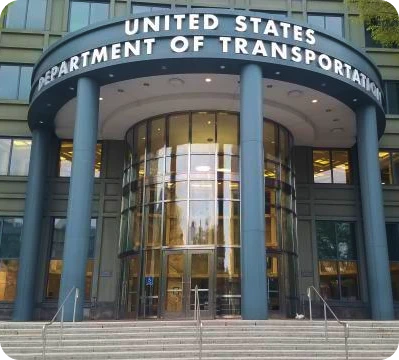Home » Blog » Truck Compliance » What Does the DOT Stand for?
DOT is short for the Department of Transportation, a key government body that works to keep transportation in the United States safe smooth-running, and easy to use. They sum up their job like this: "To help the United States by making sure we have a quick safe well-run, easy-to-use, and handy transportation system that supports our country's big needs and makes life better for Americans now and in the years to come."

What Does the Department of Transportation Do?
Picture the transportation system as a huge web of roads, train tracks, air routes, and sea lanes. The DOT works like a control tower watching over and managing this complex network through many smaller agencies. Each of these agencies has a specific job to make sure their part of the transportation system runs and without hiccups:
Federal Aviation Administration (FAA):
The FAA manages every part of civil aviation, including air traffic control and aircraft safety rules.
Federal Railroad Administration (FRA):
The FRA sets rules for railroads to make sure they run and keep their infrastructure in good shape.
Federal Transit Administration (FTA):
The FTA puts its efforts into public transportation systems. It gives money and expert help to build and upgrade mass transit choices in cities and rural areas.
Maritime Administration (MARAD):
The MARAD works to boost the growth and ability to compete in the U.S. maritime industry.
Pipeline and Hazardous Materials Safety Administration (PHMSA):
The PHMSA has the responsibility to regulate the safe transport of hazardous materials through pipelines or other methods.
Saint Lawrence Seaway Development Corporation (SLSDC):
The SLSDC takes charge of managing and running the Saint Lawrence Seaway, a key shipping route that links the Great Lakes to the Atlantic Ocean.
What is the Role of the DOT in Road Transportation?
The DOT oversees many types of transportation, but your company cares most about its job in road transportation. Three key agencies have a crucial part in this area:

National Highway Traffic Safety Administration (NHTSA):
The NHTSA aims to cut down on deaths, injuries, and money lost because of car crashes. They study road safety, create rules for safer vehicles, and spread the word about staying safe on the road.
Federal Highway Administration (FHWA):
he FHWA teams up with state and local groups to keep the National Highway System in good shape. This system forms the core of America's road network.
Federal Motor Carrier Safety Administration (FMCSA):
The FMCSA plays a crucial role for companies that run commercial motor vehicles (CMVs) like big trucks and buses. This DOT agency aims to boost the safety record of CMVs. To achieve this, it sets up rules and carries out safety checks.
Why Does DOT Compliance Matter for Your Transportation Business?
If your business uses CMVs, following FMCSA rules is essential. Operators of commercial motor vehicles need to sign up for a USDOT number and follow federal safety guidelines that the FMCSA and other DOT agencies enforce. Compliance helps to keep your vehicles running, guards drivers and cargo, and steers clear of possible fines for breaking the rules. A lot of transport firms use compliance software to simplify their methods and make sure their drivers and vehicles stay in line with federal law.
Stay Informed and Stay Compliant
The Department of Transportation has a big influence on keeping our transportation system safe and working well. If you run a business in the transportation world, you need to know how the DOT is set up and what its different agencies do. When you keep up with DOT rules and follow them, you help make transportation safer for everyone.

